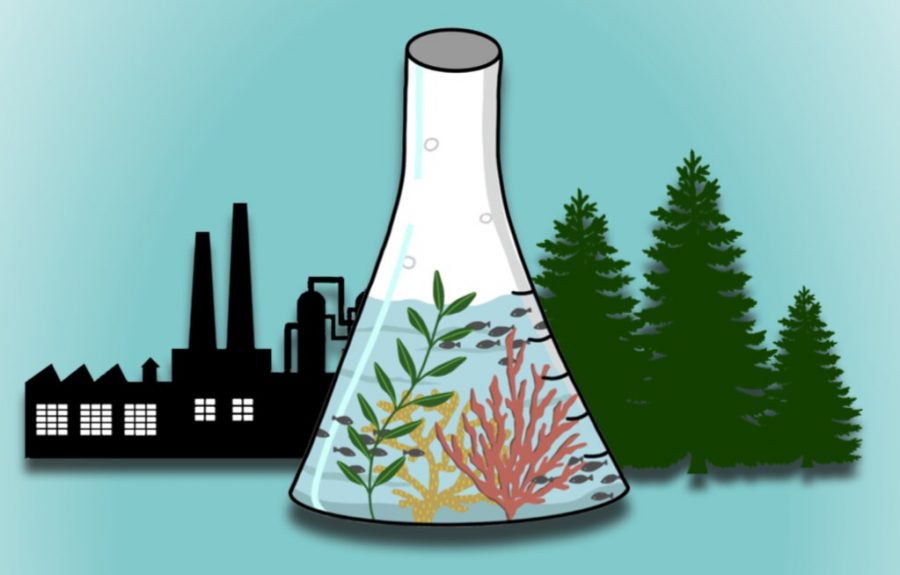Scientific breakthroughs promise progress in environmental restoration efforts
May 26, 2019
Many headlines today warn of climate change. They cite statistics showing data that global temperatures are increasing, among other effects. Other articles strongly urge action as they emphasize the limited time we have left to mitigate the effects of global warming.
We also see and hear about political actions and policies — the Green New Deal and the Paris Agreement, for instance.
While national and international efforts, as well as individual contributions, are influential, recent scientific breakthroughs also provide hope in successfully combating climate change.
Carbon capture
Publishing their findings in Nature Communications on Feb. 26, researchers at the Royal Melbourne Institute of Technology have recently been able to efficiently convert gaseous carbon dioxide into coal.
“To date, CO2 has only been converted into a solid at extremely high temperatures, making it industrially nonviable. By using liquid metals as a catalyst, we’ve shown it’s possible to turn the gas back into carbon at room temperature, in a process that’s efficient and scalable. While more research needs to be done, it’s a crucial first step to delivering solid storage of carbon,” researcher Torben Daeneke told The Independent.
Aside from the research at RMIT, other projects involving carbon capture are also promising. For instance, Carbon Engineering’s Direct Air Capture (DAC) technology is also able to remove carbon dioxide from the atmosphere.
“Individual DAC facilities can be built to capture one million tons of CO2 per year each, which is equivalent to the annual emissions of 250,000 average cars,” Carbon Engineering stated.
As people continue to burn fossil fuels for energy, the amount of carbon dioxide in the atmosphere continues to increase. In fact, according to the National Oceanic and Atmospheric Administration, carbon dioxide levels “are higher than at any point in the least the past 800,000 years.” Since carbon dioxide and other greenhouse gases trap heat in the atmosphere and are responsible for global warming, these new discoveries that can remove greenhouse gases from the atmosphere hold immense potential in combating climate change.
Microfragmentation

Carbon Engineering’s Direct Air Capture technology captures carbon dioxide from the atmosphere.
David Vaughan, a marine biologist and executive director at the Mote Tropical Research Laboratory, has been developing a technique called “microfragmentation” that splits corals into small pieces that grow quickly. This technique and its implementation paves the way towards the restoration of coral reefs, which have been heavily damaged due to climate change.
Coral Vita — a company committed to restoring damaged coral reefs — utilizes this microfragmenting technique to speed coral growth up to 50 times their normal, natural rate.
“Using a method called micro-fragmentation — splitting corals into tiny pieces that soon fuse back together — they are able to massively accelerate the growing process — with corals ready to be replanted in as little as six to 12 months, versus 30-50 years in the wild,” Yale News explained after an interview with Sam Teicher and Gator Halpern, co-founders of Coral Vita.
Given the importance of coral reefs and their continued degradation, such breakthroughs have become more crucial.
“Coral ecosystems are a source of food for millions; protect coastlines from storms and erosion; provide habitat, spawning and nursery grounds for economically important fish species; provide jobs and income to local economies from fishing, recreation, and tourism; are a source of new medicines, and are hotspots of marine biodiversity,” the U.S. National Oceanic and Atmospheric Administration stated.
Plastic degradation
A report published in April 17, 2018 by the Proceedings of the National Academy of Sciences of the United States of America details the discovery of an enzyme that is capable of degrading plastic.
“We have characterized the 3D structure of a newly discovered enzyme that can digest highly crystalline PET, the primary material used in the manufacture of single-use plastic beverage bottles, in some clothing and in carpets. We engineer this enzyme for improved PET degradation capacity and further demonstrate that it can also degrade an important PET replacement, polyethylene-2,5-furandicarboxylate, providing new opportunities for bio-based plastics recycling,” the report explained.
In addition to such an enzyme, other breakthroughs tackle the same problem. For instance, Federica Bertocchini, a developmental biologist at the University of Cantabria, discovered the ability of waxworms to degrade plastic.
“When they [Bertocchini, Paolo Bombelli and Christopher Howe] placed the worms on polyethylene plastic, they found that each worm created an average of 2.2 holes per hour. Overnight, 100 wax worms degraded 92 milligrams of a plastic shopping bag,” National Geographic reported. “At this rate, it would take these same 100 worms nearly a month to completely break down an average, 5.5 gram plastic bag.”
With 18 billion pounds of plastic waste flowing into oceans every year (National Geographic), its clear plastic pollution is an increasingly pertinent problem. These breakthroughs present an important step forward in solving this issue.
Conclusion
Carbon capture, microfragmentation and plastic degradation are just a few of the multitude of new discoveries that can aid in environmental restoration efforts. Of course, such discoveries aren’t enough on their own to solve our problem. They each have their own setbacks, as they can be slow and expensive, and the extent to which they can help combat climate change is limited by political action. Still, as new technologies continue to be developed and more scientific breakthroughs are made, environmental restoration efforts continue to gain more ground.
“With carbon dioxide emissions continuing to rise, an increasing number of experts believe major technological breakthroughs — such as CO2 air capture — will be necessary to slow global warming,” writes the Yale School of Forestry and Environmental Studies. “But without the societal will to decarbonize, even the best technologies won’t be enough.”



